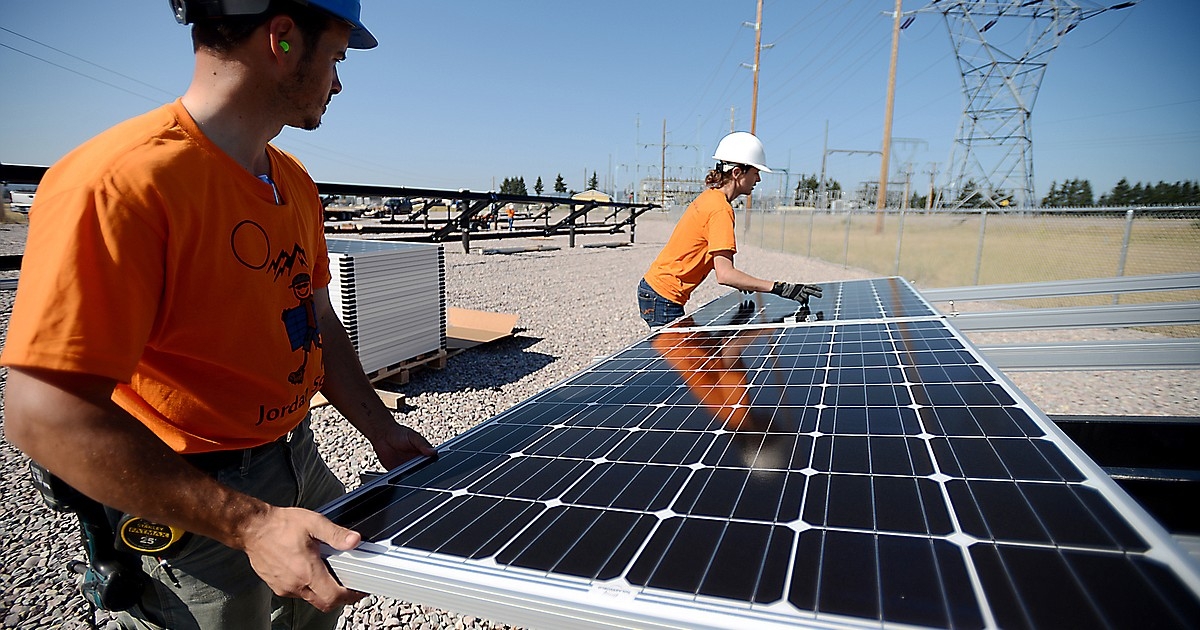Description
The Trump administration’s efforts to boost domestic energy production is shading out market opportunities for some home and business-owners in Northwest Montana.
While pushing policies to expand oil, natural gas, coal and hydropower, the federal government has pulled back programs that President Donald Trump has deemed the “Green New Scam.” Among the industries expected to be hit hardest are those involved in solar energy production.
“It’s kind of the perfect storm,” said Thomas Clark, the director of marketing and communications for the Whitefish-based solar installation company Northstone Solar.
While Montana’s dreary winter weather makes it a less-than-ideal choice for large-scale solar projects, interest in small-scale solar systems is on the rise, thanks in part to technological advancements that have made solar panels and batteries more efficient and less expensive.
About 2.5% of the homes in Montana now have solar, according to the Solar Energy Industries Association, and Clark estimated that Northstone Solar outfits between 25 and 30 homes and small businesses in the Flathead Valley with solar systems every year.
As far as the reasons clients have for pursuing a solar project, Clark said, “it’s kind of a mixed bag.”
Some want to reduce their carbon footprint, while others are looking to decrease their monthly utility bill or achieve independence from the energy grid.
Financial incentives, such as the Residential Clean Energy Tax Credit, have been a “cherry on top” for most of Northstone’s clientele. Clients who claimed the credit on their annual taxes could recoup up to 30% of the costs associated with installing a solar system, which Clark estimated to be between $10,000 and $20,000 for the average homeowner.
Congress voted to end the tax credit program this year as part of a massive budgetary bill passed in early July. The program was expected to continue through 2034.
Clark said Northstone is currently experiencing a surge in activity as people rush to install solar projects ahead of the tax credit’s deadline. He worries that business will falter next year, once clients can no longer take advantage of the tax credit.
Ongoing tariff negotiations are another sticking point, as China currently manufactures around 80% of the world’s solar panels.
“We’ve had to make hard decisions,” said Clark. “We’re stocking more than we have in the past, but we’re also worried that jobs might go away.”
“It’s hard to forecast,” he said, especially as other financial incentives that Northstone’s clients rely on may also be phased out in the coming months.
Last year, Lisa Wade Mayorga, the co-owner and operator of Montana Better Beef, worked with Northstone to install a solar system at her family's ranch outside Kila. The final bill totaled around $55,000, but Wade Mayorga was able to offset the cost with a grant from the U.S. Department of Agriculture’s Rural Energy for America Program. Agricultural producers and rural small businesses that successfully apply for the program can receive up to a 50% match on the costs to install a renewable energy system.
“I’m not sure we would have actually been able to do that all on our own,” said Wade Mayorga.
Prior to installing the solar system, Wade Mayorga said she often paid around $300 a month to keep the ranch’s freezers running. Now, she hardly ever pays for electricity. During the sunny summer months, the solar panels often produce excess energy, which Flathead Electric Cooperative will redistribute to other homes and businesses in exchange for energy credits that can offset winter utility bills.
“For farmers and ranchers, your business is pretty marginal anyways, so it really is a nice investment for us,” said Wade Mayorga. “It’s a nice savings for us.”
Wade Mayorga was so impressed with her solar system, she encouraged the meat processing cooperative she is a part of to take a similar approach. The group submitted an application through the Rural Energy for America Program last year, which Wade Mayorga said did not receive funding due to an especially competitive cycle.
The cooperative had hopes of applying again. Then, in January, the federal government froze more than $900 million in funding for the program. When the money was restored in March, the U.S. Department of Agriculture announced that recipients would have an opportunity to “voluntary revise” their projects to better align with the Trump administration’s priorities. A few months later, in May, the department released a report that promised to “disincentivize funding for solar panels on productive farmland.”
While the department still lists solar generation as one of the renewable energy systems farmers can pursue under the grant, Wade Mayorga said she is no longer hopeful that the cooperative will receive funding for a solar project.
“Things have certainly changed,” she said. “Some of these changes have had negative consequences on producers.”
SUBSIDIZING U.S. energy production is nothing new. Between 2016 and 2022, the federal government provided $183 trillion worth of energy-specific subsidies. About $36 billion of those subsidies were dedicated specifically to solar energy projects, compared to about $24 billion for coal, oil and natural gas projects combined.
“The government always tends to put a hand on the scale,” said Makenna Sellers, the executive director of the Montana Renewable Energy Association.
While she isn’t surprised about some of the ways the Trump administration has chosen to tip the scales of energy production, Sellers said programs like the Residential Clean Energy Tax Credit primarily benefit families and local businesses, rather than large institutions.
“The people that are going to be hit the hardest with this is the everyday Montanan that is looking to save on their utilities,” she said.
But Sellers’ gloomy forecast did come with a silver lining. Subsidies and tax credits have made solar energy investments more feasible for the average person, but Sellers said financial incentives are far from the only thing driving the solar boom. Technological advancements and an increasing need for domestic energy production continue to make solar an enticing option for many areas, even without federal buy-in.
“My overall viewpoint is that, yeah, it’s going to hurt, but the industry is going to innovate,” she said. “The technology is tried and true. It’s a contributor to our energy resilience.”
Reporter Hailey Smalley may be reached at 758-4433 or [email protected].
News Source : https://dailyinterlake.com/news/2025/jul/31/federal-cuts-spell-stormy-weather-for-mt-solar-industry/
Other Related News
08/01/2025
FLATHEAD LAKE Its hard to top Grace Porges Montana summer internshipA rising senior stud...
08/01/2025
The Whitefish Community Development Board voted unanimously in July to recommend approval...
08/01/2025
A Whitefish man charged for allegedly threatening a woman with a machete in Columbia Fall...
08/01/2025
The Flathead County Sheriffs Office identified a pair of Washington men as the victims of...
08/01/2025












